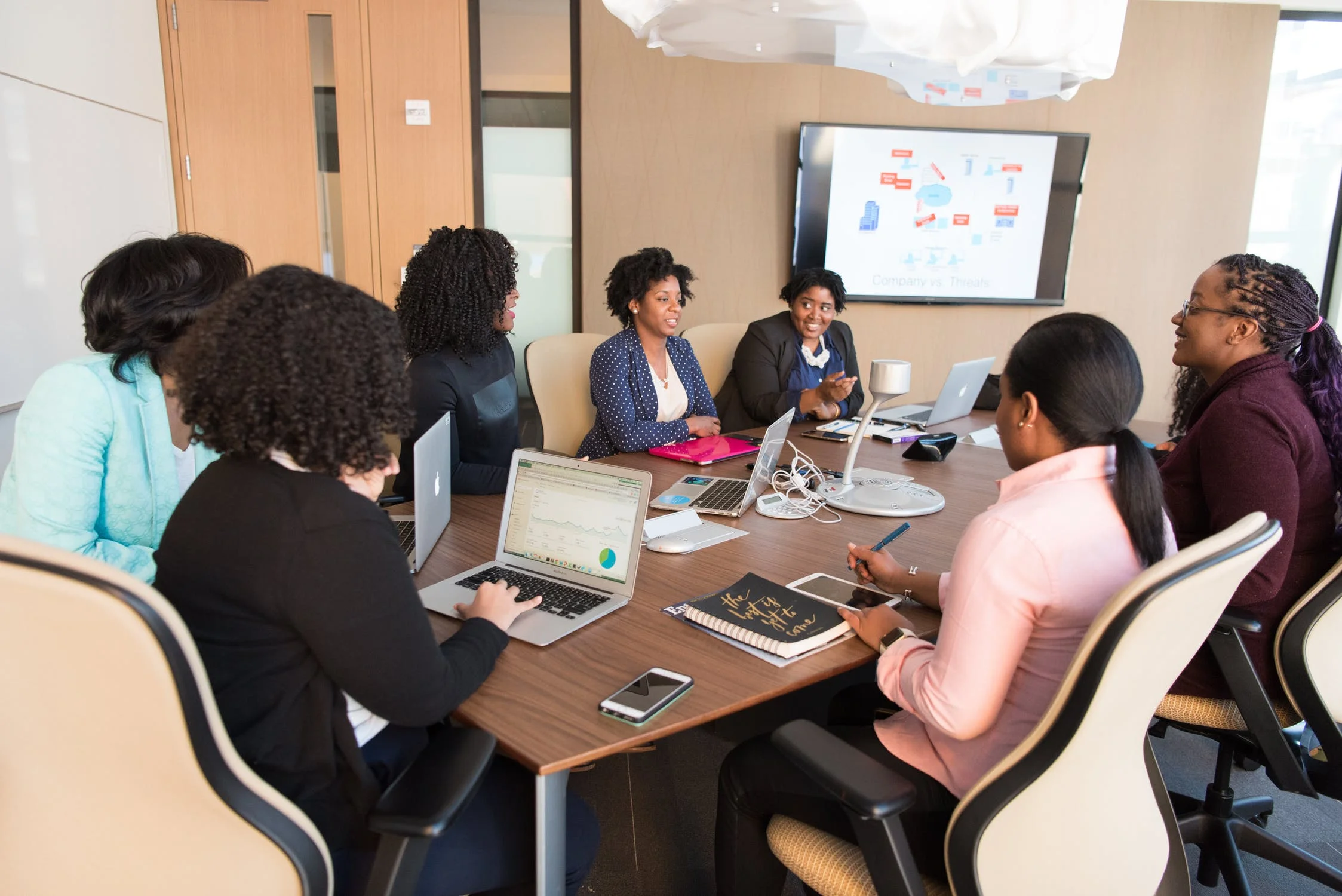The Rising Trend of Women Entrepreneurship in Healthcare and the Impact on Healthcare Accessibility
Image Description: Three women sit together on a couch, reviewing and discussing written reports.
By Marion Davis
In the US, women entrepreneurship has increased drastically in the past few years from 28 percent in 2019 to 49 percent in 2021. Part of this boom of women entrepreneurs has been an increase in disabled women founders in healthcare.
Anecdotal evidence appears to indicate that women are more in touch with the needs of their communities and their consumers–especially across intersectional identities.
Meeting consumer needs can naturally be profitable, but the community-first versus profit-first approach often unearths biases from potential funders.
In a quest to improve healthcare accessibility in the US, many women entrepreneurs are creating their own paths to navigate the male-dominated world of funders and achieve business success while improving patient outcomes.
Gender Diversity in Healthcare Founders and Addressing Consumer Needs
One common theme in women founders’ approach to business in healthcare is a strong understanding of community needs and a plan of approach that addresses consumer pain points.
Rather than simply professing the need for a vague concept of accessible healthcare on social media to rounds of virtual applause as some male healthcare CEOs tend to do, these women entrepreneurs move forward to enact accessible healthcare, recognizing what factors contribute to accessibility within their communities.
Accessible Mental Healthcare for Black Patients
As a Black disabled therapist originally from a rural area of Georgia, Brittany Hardy knows the importance of accessible mental healthcare. More importantly, she understands exactly what makes up accessible care.
With one of the largest Black communities in the US, the state of Georgia feels the lack of minority representation in healthcare more severely with an extreme mismatch between patient demographics and provider demographics. Thirty-three percent of Georgia residents are Black, and yet the national average for Black therapists is only four percent.
Creating The Hardy Clinic in Atlanta in 2018, Brittany Hardy recognized that accessible care meant cultural competency, telehealth services, affordable prices, and intersectional identity representation.
Brittany invests in regular workshops for her team of women of color therapists and interns to be aware of mental health issues across cultures. The Hardy Clinic offers sliding scale fees for the uninsured and virtual services so that people in rural areas outside of Atlanta can also access care.
More recently, Brittany created an academy side to her clinic to mentor minority women interns, recognizing that many women of color are graduating with psychology degrees but cannot find opportunities to gain practical experience and thereby are not entering the field of psychotherapy.
Accessible Primary Care for Neurodivergent Patients
Katya Siddall is the disabled and neurodivergent woman founder of Hopper Health, a patient-centered medical home for neurodivergent adults that provides virtual primary care and health navigation services for more than 20 percent of the population that may have sensory, information-processing, or communication differences that can lead to inadequate care.
As an autistic woman, Katya may perceive and describe pain differently than what doctors expect which can lead to failure to diagnose and for these physicians to ascribe any symptoms to anxiety or stress–as is a common experience for neurodivergent women patients. After years of consulting with primary care providers on the source of her persistent stomach pain, Katya was hospitalized with internal bleeding to get a colonoscopy and was diagnosed with severe Crohn’s disease.
Katya recognized that the neurodivergent community in the US needed primary care that would take patients seriously and funnel patients into the specialty care they needed quickly and without stress. Katya outlined a plan of action for accessible care; first, there would be representation of neurodivergent providers in the care team at her primary care center, and second, she would make use of a virtual clinic to overcome accessibility barriers.
Virtual care made more prevalent by the pandemic brought a revolution to healthcare access for disabled people. In one study, 88 percent of patients found that telehealth was more convenient than in-person visits and approximately 91 percent of patients were satisfied with video consultations. Virtual care supports patients in overcoming transportation barriers and costs, mobility-related barriers, and so on, serving as a valuable tool in healthcare access.
Currently, Katya is prioritizing representation across intersectionality, increasing cultural and racial diversity present at Hopper Health within her neurodivergent team. People of color are the most marginalized in the neurodivergent community and within healthcare and are in need of representation in care.
Accessible Primary Care for Rural Health Patients
Kristin Speer is a residency-trained, board-certified clinical pharmacist. Her practice and career experience have centered around hospice and palliative care along with other specialties. After she became burned out by the corporate world like many other pharmacists, it made sense for her to transition to entrepreneurship. She established a non-profit and is now working on three start-ups, including a rural healthcare solution.
Kristin is a chronic pain patient and manages her shoulder, back, and nerve pain with non-drug methods. She feels that this further adds to the invisible nature of her chronic pain. She experiences other symptoms related to memory and mental health but does not want a formal diagnosis because she believes this could limit her confidence or create a burden of decision-making over whether she shares this often-stigmatized information with others.
While she is unclear how to define her health situation specifically, she is informed by her own health experiences and eager in her dedication to providing health solutions to patients with less access due to geographical location. More than 15 percent of Americans live in rural areas and are more likely to die from “heart disease, cancer, unintentional injury, chronic lower respiratory disease, and stroke” according to the CDC. A large contributor to the large disparities in health between rural and urban Americans is the lack of access to preventive care managed by a primary care provider (PCP). In rural areas, the average number of PCPs is 39.8 physicians per 100,000 people in the community versus 53.3 physicians per 100,000 people in urban areas.
To address this gap, Kristin has the goal of bringing more accessible health care to rural communities in the form of free-standing, ADA-compliant telephone-like booths with telehealth primary care services and state-of-the-art digital assessment technology across rural communities in the US. Kristin recognized that telehealth and digital health are major avenues to improving patient access to physicians to manage their care. However, in rural areas, patients are more likely to have poor internet connection as well as less likely to have compatible mobile devices.
In her unique take on patient needs in the US, Kristin sees part of the larger healthcare accessibility picture as rural health residents having access to free-standing booths with digital tools and a reliable internet connection. This plan removes the cost and connectivity barrier that prevents rural health residents from fully benefiting from telemedicine.
Women Entrepreneurship and the Gender Gap in Funding
While some reports say that women are more likely to receive funding, other reports indicate that the opposite is true. The reality is that the problem is multi-faceted and depends on the funding source. Women are less likely to ask for funding and also tend to request lower amounts of funding in the form of business loans. When approaching venture capitalists, women tend to be asked a different set of questions than men are asked and this often results in less funding–or no funding at all–for these women.
Venture Capital Financing as a Boys’ Club
Venture capital is quickly becoming a major way to secure funding for modern start-ups.
However, the lack of gender diversity among venture capitalists presents a problem for women-owned businesses seeking funding.
A 2019 press release by Columbia Business School described the issue: “Two-thirds of the issue is that we do not even see the women become entrepreneurs in the first place or start companies with the right underlying characteristics for attracting [venture capital] financing."
Since then, women entrepreneurship jumped from 28 percent in 2019 to 49 percent as of 2021.
Now that the first point is no longer applicable, the second point needs to be addressed.
What exactly are the right underlying characteristics to attract venture capital financing?
Men in the US make up more than 91 percent of all venture capitalists and white men specifically make up 58 percent of all venture capitalists with the industry commonly termed a boys’ club.
Venture capitalists are more likely to fund a business idea that appeals to the male majority, shooting down innovative business approaches by women–particularly minority women. This fact is especially evident in the rise of women entrepreneurs in healthcare creating approaches to address care needs across intersectional identities and underserved populations.
Women Founders in Healthcare and the Struggle to Obtain Funding
With the onset of the pandemic, there has been a rise in innovative approaches to medical care with the healthcare industry predicted to grow at a rate of 6 percent from 2021 to 2025 compared to five percent in the pre-pandemic times.
In one article, Forbes reviewed 52 women-led startups that are propelling forward the future of HealthTech and FemTech. FemTech refers to the use of digital tools to support access to women’s healthcare.
The Forbes article found that only three percent of HealthTech funding in 2020 went to FemTech companies despite the FemTech category being expected to expand to $1.07 trillion by 2026.
A possible reason for such low funding is the gender disconnect between the rapid rise of women entrepreneurs and the male-dominated field of venture capital. One venture capitalist told a woman entrepreneur that he found women’s health boring and therefore would not invest.
In the early stages of creating Hopper Health, Katya Siddall had a similar experience with a disconnect with the minority experience as she was told by venture capitalists that they did not think that disabled people cared enough about healthcare access to pay for accessible care.
In fact, simply looking at any recent government report on healthcare would have informed this venture capitalist that inaccessible care is a major issue lamented by disabled and neurodivergent patients.
Working Against Misconceptions to Obtain Funding
As a successful autistic woman professional, Katya has struggled to be taken seriously by investors–both regarding her own past history of success and her autism diagnosis along with her for-profit business model. Katya has proven financial know-how as a health plan executive who ran a multi-billion dollar product organization and is now a second-time tech founder of a successful company with Hopper Health.
The difference now in her second lap around the track is that she faces difficulty in raising capital with a business model centered on meeting the consumer needs of the neurodivergent community. While conversations with healthcare investors typically go well for her, Katya often encounters a push to use “autism funds”–in other words: funds allocated to treating autistic people like charity cases.
Organizations like Autism Speaks have infamously spoken over the voices of the autistic community to infantilize autistic individuals and to utilize the autistic community as a charity magnet, redirecting funds to primarily go toward paying the non-profit executives’ salaries that are the highest among all autism non-profits at over $600,000 in some cases. In fact, infantilizing and pathologizing the autism community has increasingly become big business by the neuro-majority.
As Katya has experienced, she does not match the caricature put forth and perpetuated by many autism non-profits. Able to speak eloquently and with an impressive career, Katya’s autism diagnosis is often downplayed by autism investors who invalidate the struggles she has faced as a neurodivergent woman to achieve these accomplishments in a non-supportive world. These autism investors question her ability to create a viable product for other neurodivergent individuals since Katya does not match their perception of an autistic person. Katya seeks to empower other autistic people through healthcare access, seen as a privilege in this country, and this empowerment approach does not align with the big business of infantilizing autism.
Fighting Against an Infrastructure Designed to Create Barriers to Success for Women
From a healthcare provider perspective, Kristin Speer believes that US society is not set up to support the professional success of women—especially mothers. Compared to the experiences of men, women, in Kristin’s eyes, do not have access to the same privilege of a social and economic infrastructure that supports women in becoming successful. This fact is evidenced in the absence of paid maternity and paternity leave, subsidized early childcare and education, and equal pay across genders.
As a pharmacist, Kristin is closely familiar with gaps in healthcare her patients encounter and possesses impressive leadership and business development experience in leading clinical teams, executing revenue ideas, and delivering value propositions while working as an employee. In venturing out on her own, however, like so many other women, she struggled to raise capital to get started.
In general, while women face bias when they do seek funding, women entrepreneurs are also 80 percent less likely to request funding than their male counterparts.
As the adage says: “behind every great man, there is a great woman.”
Reversing this axiom, Kristin created a team of great men to support her. She relied on several men including her husband to help her secure funding for her business, form business partnerships, secure loans, raise capital, and establish two LLCs.
Kristin finds that women are so accustomed to taking on everything themselves that this affects their approach to entrepreneurship—from forming a business to funding the business. Instead, women entrepreneurs must rely on resources available to them to have a greater chance of success. Kristin is acutely aware that 45 percent of start-ups do not last past the fifth year and encourages women to overcome any fears of leaning on support so as to increase the chance of their businesses surviving and thriving.
Kristin believes that the economy and the world are better when women are not just included but centered in entrepreneurial endeavors.
Final Thoughts
In a world where healthcare accessibility is heavily discussed, few individuals move beyond paying lip service to the idea. Affordability of care in the US is one factor and likely the most heavily discussed factor. However, healthcare accessibility is much more nuanced than this.
Virtual options for care, representation in care, cultural competency in care–these factors all play a role in accessibility.
This is where women business owners have stepped up to the plate within the recent rise of women entrepreneurship.
With their fingers on the pulse of trends in underserved communities, and of diversity within these communities, these women entrepreneurs have recognized human needs and created a plan for actionable accessible care.
However, with gender biases in US culture, these women entrepreneurs often struggle to be taken seriously when it comes to accessing funding. An inability to access funding for the important community-focused projects women are creating can hamper societal progress. Society improves with the innovative leadership of women at the fore–and especially across intersectional identities.
Overall, the solution to the problem of inaccessible healthcare is clear: women entrepreneurs in the industry must be centered and uplifted.
Marion Davis is a contributing writer at EmployDiversityNetwork.com. She is a disabled DEIA consultant and writes on the value of diversity and inclusion across multiple industries, specifically as relates to disability and intersectionality.











